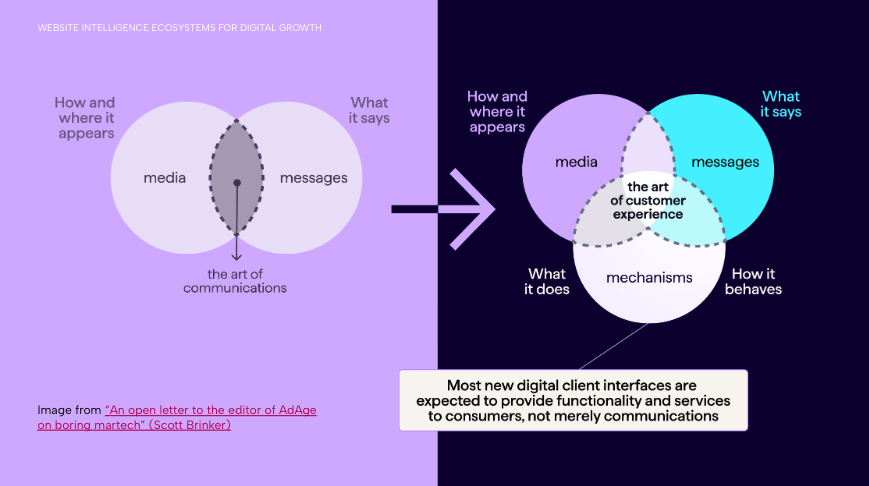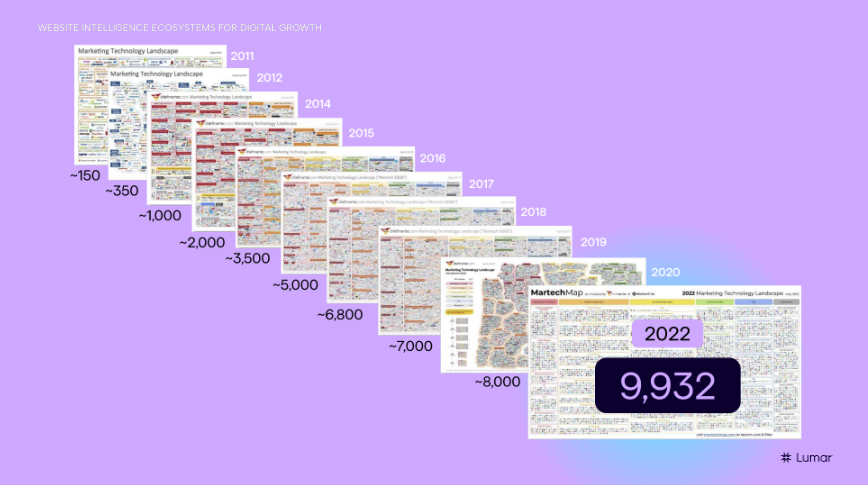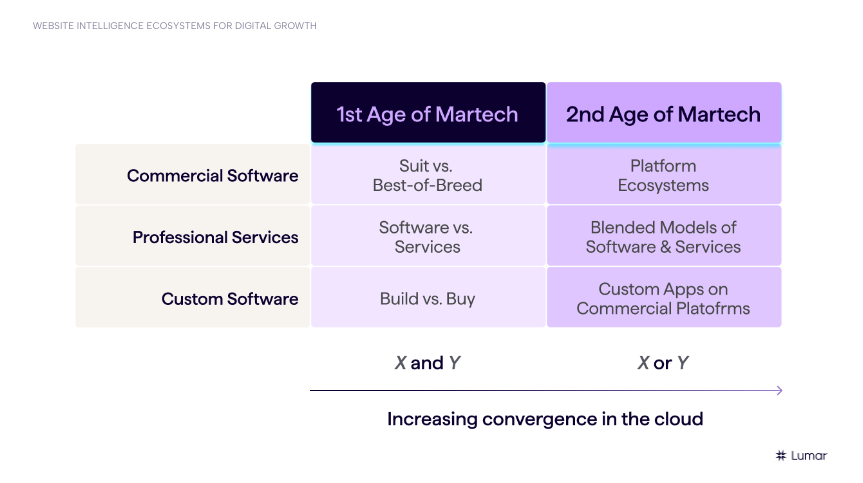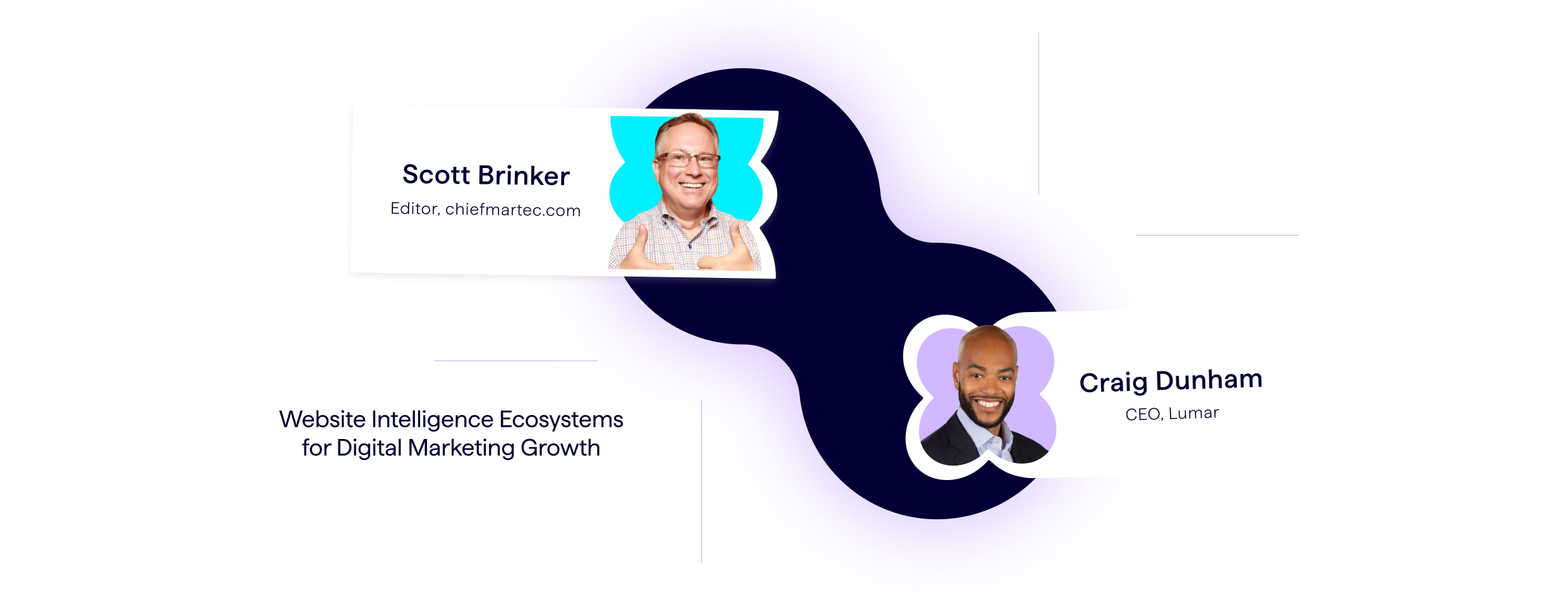For this in-depth discussion of MarTech platforms and the future of website intelligence, Lumar CEO Craig Dunham was joined by “godfather of MarTech” Scott Brinker, the founder and editor of chiefmartech.com. Brinker has been analyzing and commentating on the MarTech landscape for over 15 years now and helps produce the popular yearly marketing technology maps at martechmap.com.
Watch the full webinar on-demand above (including Q&A session!), or read on for the key takeaways. For marketing leaders, website managers, and SEOs alike, there’s plenty to learn about the current state of website intelligence from this discussion between two MarTech heavyweights.
Why websites are a crucial marketing channel in 2023 and the importance of website health
Brinker notes that brands today are having to deal with a very rapid proliferation of marketing touchpoints, both online and offline.
“Part of what we wrestle with is the explosion of channels,” he says. “All of these other channels ultimately lead people back to your website.”
“There is a common thread across almost all of these channels. If you think of them as a massive solar system of planets and moons and asteroids flying by, the sun is the center of gravity. And that’s what the website is. Almost all of these other channels ultimately lead people back to your website. And with good reason.”
— Scott Brinker
Not only does your business’s website have to be discoverable via organic search, backlinks, and social posts, today, websites increasingly need to be inclusive and provide a positive customer experience that will ultimately lead to conversions and sales. Brinker references the shift in marketing strategies from focusing on just ‘messages’ and ‘media’ in marketing communications to a more 3-dimensional approach that also factors in mechanisms as a key element of the customer experience. Your website is a prime example of a marketing mechanism in this framework, adding new levers for marketers to pull around interactive digital interfaces and user experience.

“We realized that a lot of the reasons people come to our websites is because there are actions they want to take,” Brinker says. “It is truly an interactive medium. The way those mechanisms work actually says as much about our company and what we’re trying to communicate as the messages and the media itself.”
Brinker points out that if you’re ignoring the technical aspects of your website, the flow around, the user experience – you could be undermining the whole premise of your brand.
Getting the technical and UX aspects of your site right in and of itself is a challenge, but websites themselves are dynamic evolving things – with changing purposes and a growing number of cross-functional stakeholders. Your website requires ongoing monitoring, prioritization, and improvement to reach its full potential. In their role as marketing ‘mechanisms’, businesses’ websites should satisfy the customer but also need to serve the needs of various internal stakeholders, from marketers to product developers, sales teams, and so on.
The state of MarTech in 2023: ecosystems, flexibility, and connectivity
According to Brinker, businesses frequently assume that their MarTech stack is far smaller than it is in reality. When he’s done MarTech stack analyses, he says he will often poll businesses about how many different platforms they are using — then, when they do a technical audit, it’s not unusual for the actual number of platforms in use to be nearly 5x their initial assumption. Most companies use a lot of software.
“As your organization gets larger, different stakeholders tend to have their own tools that they’re using for their purpose,” he says. “Not all of them are massive platforms, there’s such a long tail of specialized niche tools that people use for different things that sometimes we can lose track of them. It’s really important to increasingly get these pieces of software working together.”
In this omnichannel, CX-led world, MarTech is vital for businesses’ growth efforts. But in the wake of the pandemic and fairly tumultuous economic times, Brinker sees a lot of businesses going through something of an efficiency review when it comes to their MarTech stacks.
“What do we really need? What needs to work well? Let’s get this well-prioritized.”
Brinker says that as companies are going through these rationalizations, they’re becoming aware of their websites as not just one singular component of their broader growth efforts, but really as an ‘ecosystem player’ across the other things teams are trying to accomplish across their MarTech stacks.
Dunham mentions that one thing he’s seeing a lot of in the market is companies prioritizing more organic marketing channels, like their websites.
“As they’re doing that rationalization, as they’re looking at ‘how are we spending’, there has historically been a big over-reliance on paid ads to drive revenue. Much of our discussion has really been about the organic impact that having a good, solid, sound website can have for your businesses,” said Dunham. “And we are seeing that shift; no one is turning off paid ads entirely, but they are taking a portion of the budget that they were using for that and applying it to more organic channels.”
Today’s website intelligence ecosystem and platform developments
Brinker is well known for his annual MarTech map which he has been updating for over a decade. So, of the MarTech trends he’s noticing in 2023, what does he see that might impact businesses’ website intelligence efforts moving forward?

“Overall, two forces keep happening in the MarTech landscape,” Brinker says. “One, there is consolidation that happens. We get companies for core capabilities that are firming up being a leader in their space. But at the same time, the number of new start-ups that keep entering the space continues to exceed the rate at which things are leaving the space.”
Additionally, he points to the adoption of generative AI tools being used for content (and image, and code) production. The implication of this is that the amount of content that is going to exist in the world is going to grow at a significantly faster rate than it has been. And while Brinker doesn’t advise businesses to turn their marketing engine over to an AI, we are already seeing it accelerating the speed at which content is produced, beyond simply text-based media. Brinker sees this as the best of times and the worst of times for those in content marketing. Marketers can accelerate the pace and capabilities we have, but the challenge is managing it well. You don’t want to create a cacophony of poor-quality content, and certainly don’t want that kind of cacophony to define your brand.
“Having the right systems in place becomes that much more important to make sure the experience you’re creating is solid, is sound — and that you can be found,” adds Dunham. “There’s a lot of clutter. And our attention spans are shrinking, we’re darting our eyes everywhere these days. So it becomes important to make sure that you have authority in your message and to make sure that the systems that are delivering those messages are solid and sound.”
(Note: For those marketers eager to ensure their content is found among the potential flood of cacophonous content coming this year, it’s worth bolstering your technical SEO efforts to ensure your underlying website foundations are poised to help your content rank well amid the noise — Lumar can help marketing teams get their technical SEO efforts ready for a crowded future of website content.)
Brinker also stresses the importance of having strong MarTech ecosystems in place to ensure platforms aren’t operating in siloes and can be connected together to get maximum value. He calls the current marketing technology landscape the “Second Age of MarTech,” one where marketers seek the cohesion of a centerpiece platform for a core capability that can easily connect off to other tools that relate to their mission. He gives the example of using Lumar as an organization’s center of gravity for website intelligence and using integrations to bring more data into this centralized ‘command center’ for website intelligence.

“We’ve seen this within our own software and the way that our customers engage with us and use the technology of website intelligence,” Dunham says, “We’ve got a bunch of different players [that use the platform]. We’ve got marketing teams, SEO teams, product managers, web development teams, and senior leadership — each with slightly different but interconnected interests. So we’ve done our best to create this ecosystem of software capabilities that cater to each of those specific audiences. They all have to work together really well, so there are things like partnerships with web developers on the ability to integrate the platform within a QA environment to prevent harmful code from disrupting the customer experience on their website, then there are SEOs who are leveraging the technology to audit the site and find problems, prioritize them, and communicate really easily with the web developers around the problems. There’s the monitoring of the site that’s a separate sort of dynamic of this ecosystem to make sure that new issues, as they arise, get flagged and people get notified right away. And supporting all the work around, ‘how do I communicate the impact of the work I get done with senior leadership, as I have to make sure that I can prove an ROI and why this is important.”
On top of the expanding set of capabilities with a platform itself, it’s also key for the platform to be able to talk to all of the other technologies a team has within the business as well. The old ‘build vs buy’ dichotomy is changing as platforms become more flexible and allow more bespoke set-ups through APIs and broader customization options. Users don’t need to reinvent the wheel, they can get core capabilities ‘off the shelf’ and tailor the layer on top of that to meet any more specific needs that might be unique to their business or use case.
In the Second Age of MarTech, “all of these things have a sort of meta-theme of convergence,” says Brinker. Being able to understand how all these ecosystems work together becomes more and more important.
“We’re seeing this pattern now across a variety of platforms in MarTech,” Brinker continues. “I think – not that we don’t, as an industry, still have further we can go to make this better – but you’re starting to see a more orchestrated view of the MarTech stack.”
For Brinker it’s an ongoing process of learning. The space is evolving quickly and he is enthused by vendors working to help customers learn about the capabilities of their technology, but also how it will fit within the broader MarTech ecosystem today and tomorrow.






